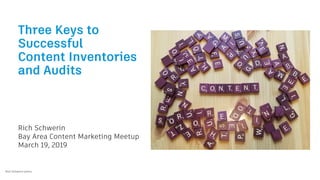
Three Keys to Successful Content Inventories and Audits
- 1. Three Keys to Successful Content Inventories and Audits Rich Schwerin Bay Area Content Marketing Meetup March 19, 2019 Rich Schwerin photo
- 2. Welcome and thanks for the dialog Agenda ▪ Introductions: Sharing collective knowledge ▪ Eight reasons to inventory & audit content ▪ Step 1: Inventory—What do you have? ▪ Step 2: Audit—How is it performing? ▪ Step 3: Execute—Does it spark joy? ▪ Buyer’s journey meets content lifecycle ▪ Content inventory & audit resources Rich Schwerin • Autodesk content strategy • VMware digital strategy • Oracle social media marketing, brand & creative, video, product marketing, publishing, events, live broadcasting • Two dot-bomb startups • Ziff-Davis tech magazines editorial (back in the day) Husband, dad, mountain biker, Grinduro/Dirt Fondo racer, @Greencognito
- 3. Creative Commons, Pinwheel Galaxy https://en.wikipedia.org/wiki/File:M101_hires_STScI-PRC2006-10a.jpg Who are you? Why are you here?
- 4. Eight reasons to inventory & audit your content 1. SWOT: Understand your content strengths and weaknesses 2. Gain a horizontal view across all channels (transcend silos) 3. Help align goals, guidelines > Identify inconsistent content 4. Improve internal efficiency, effective reuse; mitigate duplication 5. Improve external efficacy, accelerate audience journey 6. Raise content quality, performance; fill content gaps 7. Help create/reinforce a content lifecycle and overall strategy 8. Move from reactive, random acts of content to a purposeful publishing plan that drives business outcomes through a consistent content experience Start with Why, Simon Sinek https://startwithwhy.com/
- 5. First inventory, then audit ▪ Start with a content inventory ▪ Understand what content you have ▪ Quantitative, comprehensive spreadsheet ▪ Consolidated collection of content data ▪ Assets, types, formats, channels, audiences ▪ Then, based on that inventory, do a content audit ▪ Understand how your content is performing ▪ Qualitative evaluation; analytical assessment ▪ Delivering audience needs/business goals? ▪ Weigh against content KPIs, quality criteria, editorial standards, lifecycle ▪ Scope and cadence? Depends on content volume, velocity, your situation, and SMART goals ▪ Full vs. sample vs. partial (date range, directories, types, formats, channels, audience) ▪ Annual overhauls; quarterly cleanings; situational (anomalies, GTM/new initiatives, new client) Two different, complementary, sequential, perpetual efforts go hand-in-hand Creative Commons Zero (CC0) license, Pixabay https://www.pexels.com/photo/pile-of-covered-books-159751/
- 6. Step 1: Inventory—What do you have? ▪ Think like a retailer: Take stock of what you’ve got ▪ Collect and consolidate data about your content, usually in spreadsheets, capturing data you deem critical such as: ▪ Your mileage will vary: Data depends on goals/objectives ▪ Only capture data that offers insights which lead to action REI.com #OptOutside; Rich Schwerin .xls screenshots
- 7. Step 2: Audit—How is it performing? Effective content addresses audience needs and meets business objectives ▪ Collect and consolidate qualitative performance data you deem critical such as: ▪ Attention > Engagement > Action Creative Commons Zero (CC0) license, Pixabay https://www.pexels.com/photo/abstract-bright-close-up-color-268460/ Target Audience Engagement / Consumption Channels Journey Stages Next Steps Content
- 8. Step 3: Execute—Does it spark (audience) joy? Analyze results, assess performance, and assign content grades based on your goals: ▪ Keep (Grade A) ▪ Sparks audience joy, meets business goals ▪ How might we amplify, boost, reuse, syndicate? ▪ Revise (Grades B and C) ▪ Might need a refresh/update/consolidation ▪ What does the “comeback” tour look like? ▪ Delete (Grades D and F) ▪ Remove the ROT (Redundant, Outdated, Trivial) to reduce internal/external costs ▪ “Born on” dating and expiration dates | technical/factual accuracy/currency ▪ Annual amnesty day for content hoarders, curmudgeons, deniers ▪ Deletion compliance issues? Partner with Legal; archive and hide from search? ▪ Extra Credit: Fill the Gaps Identify, prioritize new content (persona, stage, topic, type) Tidying Up with Marie Kondo, Netflix https://www.netflix.com/title/80209379
- 9. Buyer’s journey meets content lifecycle ▪ Content inventories and audits help inform content lifecycle from discovery to deletion ▪ Audience-centric content, the KPIs to measure content performance, and content lifecycle vary by journey stage ▪ Map your content and its’ lifecycle to your buyer’s journey ▪ It’s an infinite loop, not a funnel. Discuss. PurchaseDrive Demand Scale Success Awareness Consideration Preference Onboard Master/Advocate Renew / Expand
- 10. Content inventory and audit resources ▪ How to Conduct a Content Audit | Melissa Harrison, Allee Creative | #CMWorld chat 1.15.19 twitter.com/i/moments/1085239606595985409 twitter.com/MHBossLady ▪ Content Audits and Inventories | CAT | Paula Land, Strategic Content xmlpress.net/content-strategy/audits-and-inventories/ content-insight.com/resources twitter.com/content_insight ▪ 33 Amazing Content Audit Tools for Easy Content Analysis | DynoMapper dynomapper.com/blog/12-content-audits/283-top-content-audit-tools ▪ How to Stop Worrying and Love Content Inventories and Audits | Marcia Riefer Johnston (Paula Land Q&A) contentmarketinginstitute.com/2015/12/content-inventories-audits/ twitter.com/MarciaRJohnston/ ▪ How to Audit Big Websites | Brain Traffic blog (Kristina Halvorson) braintraffic.com/blog/how-to-audit-big-websites ▪ URL Profiler | Tool audits links, content, social data urlprofiler.com/ Thank you!
